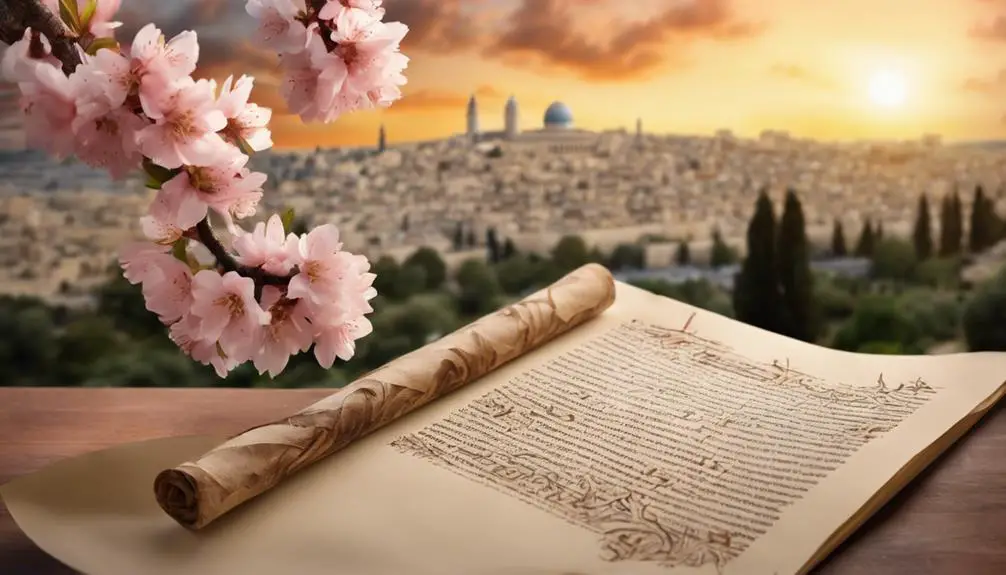Peek into the ancient and enduring significance of Nisan in the Bible and discover its pivotal role in Jewish history and tradition.

The Month of Nisan in the Bible
Did you know that the month of Nisan is mentioned more than any other month in the Bible?
This isn't just a trivial fact; it underscores Nisan's pivotal role in biblical history, especially considering its association with Passover, a cornerstone of Jewish faith and tradition.
As you explore the origins of Nisan, its biblical significance, and how it is observed today, you'll uncover layers of history and tradition that continue to influence modern practices.
Let's embark on a journey through time to understand why Nisan holds such an esteemed place in both ancient texts and contemporary faith communities.
Key Takeaways
- Nisan marks the beginning of the Hebrew calendar, symbolizing new beginnings and transitions.
- It is central to the celebration of Passover, including significant rituals like the Seder.
- Key biblical events, such as the Exodus and the Crossing of the Jordan River, are associated with Nisan.
- Nisan integrates natural cycles with spirituality, reflecting on renewal and faith in biblical context.
Origins of Nisan

Tracing its origins back to ancient times, Nisan emerges as the first month in the Hebrew calendar, deeply rooted in biblical history and religious observance. The etymology of Nisan, often linked with the Akkadian word 'nisānu,' reflecting the concept of 'beginnings,' underscores its pivotal role in the cycle of time and spirituality. This association hints at a time of renewal and rebirth, aligning with the spring equinox's natural regeneration.
Nisan's calendar significance can't be overstated. It marks the commencement of a new agricultural and religious year, intertwining natural cycles with profound spiritual milestones. Historically, this period signaled the start of barley harvest, a crucial economic activity, thereby weaving the temporal with the sacred. In biblical narratives, Nisan is positioned as a time of transition and reflection, a theme that resonates through its observances and rituals.
Analyzing Nisan within the broader context of ancient Near Eastern calendars reveals its unique role as a bridge between the celestial and the terrestrial. It's not merely a division of days; it's a period rich in symbolism, marking moments of communal and individual renewal. This deep-seated intertwining of the natural and the divine within the framework of Nisan highlights its enduring legacy in shaping religious and cultural identity.
Nisan and Passover
Building on the foundational role of Nisan in the Hebrew calendar, Passover emerges as a central observance, intricately linked to this month's themes of rebirth and renewal. You'll find that Passover customs and Seder significance are deeply woven into the fabric of Nisan, reflecting the historical and spiritual liberation of the Jewish people from Egyptian bondage.
The Passover Seder, a ritual feast marking the beginning of Passover, embodies the essence of Nisan through:
- The Retelling of the Exodus: Participants recount the Israelites' departure from Egypt, emphasizing themes of freedom and redemption.
- Eating of Matzah: Symbolizing both the Israelites' haste in leaving Egypt and the bread of affliction, matzah is a key element in Passover observance.
- Bitter Herbs: Consumed to remember the bitterness of slavery, reinforcing the contrast between past subjugation and present freedom.
- Four Cups of Wine: Each cup represents steps of redemption, further highlighting the celebratory aspect of deliverance and renewal.
Through these practices, you engage directly with the historical and spiritual narratives that shape the Jewish identity, making Passover a profound time of reflection and celebration within the month of Nisan.
Key Events in Nisan

Nisan's calendar marks several pivotal events that have shaped the course of Jewish history and religious practice, demonstrating its significance beyond the Passover observance. This month isn't just about commemorating the Exodus; it's deeply intertwined with the agricultural significance of spring's arrival, marking a period of renewal and hope. As you delve into Nisan's historical and religious underpinnings, you'll find that its celebrations are imbued with layers of meaning, reflecting both the joy of liberation and the reverence for nature's rebirth.
Event |
Date (Nisan) |
Significance |
|---|---|---|
Creation of the World |
1 |
Symbolizes renewal, celebrated with optimism for future growth and prosperity. |
The Binding of Isaac |
15 |
Represents faith and sacrifice, evoking deep reflection on devotion and obedience. |
Crossing the Jordan River |
10 |
Marks a pivotal moment of transition and the promise of a new beginning. |
The Fall of Jericho |
16 |
Illustrates divine intervention and victory, inspiring hope and faith in providence. |
These events, spanning from creation myths to historical milestones, enrich Nisan's celebrations. They underscore the month's agricultural significance, marking not just a time for religious observance, but a period of communal reflection, renewal, and joy.
Nisan Today
Reflecting on the historical and religious significance of Nisan reveals its enduring impact on contemporary practices and observances within Jewish communities today. This month, rich in biblical narratives and commandments, continues to shape the spiritual calendar and rituals in significant ways. Here's how:
- Passover (Pesach): Central to Nisan celebrations, Passover commemorates the Exodus from Egypt. Modern observances include the Seder meal, where the story of liberation is retold, connecting participants with their ancestral past through symbolic foods and prayers.
- Counting of the Omer: Beginning on the second day of Passover, this practice involves a daily count leading up to Shavuot. It reflects an agricultural calendar and symbolizes the link between Passover and the giving of the Torah.
- Rosh Chodesh Nisan: The new moon of Nisan marks the beginning of the month. Today, it's observed with special prayers and possibly a more festive meal, acknowledging the month's significance as the start of the biblical new year.
- Special Torah Readings: Throughout Nisan, specific Torah portions are read that relate to Passover and the themes of redemption and freedom, reinforcing the month's historical and spiritual lessons in today's context.
These practices encapsulate the blend of historical reverence and contemporary relevance, demonstrating how Nisan celebrations continue to evolve while remaining deeply rooted in tradition.
Reflections on Nisan

Considering the multifaceted role of Nisan in the Bible, it's essential to explore how this period has shaped and continues to influence Jewish religious practices and cultural identity. The Nisan rituals, deeply embedded in the fabric of Jewish life, offer a lens through which you can examine the complex interplay between faith, tradition, and the natural world. This month, marking the beginning of the agricultural year, holds profound agricultural significance, reflecting the ancient Israelites' close ties to the land and their dependence on its cycles for survival.
The observances and customs practiced during Nisan, such as the Passover, not only commemorate historical events but also reinforce the bond between the community and their environment. These rituals serve as a reminder of the interdependence between people and the earth, highlighting themes of renewal, liberation, and gratitude that are as relevant today as they were millennia ago.
Your understanding of Nisan's impact extends beyond religious observance; it encompasses the recognition of humanity's enduring connection to the natural world. This reflection invites a deeper appreciation for the ways in which agricultural rhythms have historically shaped, and continue to shape, cultural identities and spiritual practices.
Frequently Asked Questions
How Do Different Jewish Communities Around the World Celebrate Nisan in Contemporary Times, Especially in Non-Religious Contexts?
In contemporary times, you'll find Jewish communities globally celebrating Nisan through community gatherings and cultural expressions like Nisan art, even beyond religious contexts. These gatherings often emphasize unity and heritage, blending traditional motifs with modern interpretations.
Nisan art, for instance, becomes a medium for exploring and expressing identities, bridging ancient traditions with contemporary life.
These celebrations serve not just as cultural observances but also as opportunities for communal reflection and connection.
Are There Any Specific Foods or Recipes Traditionally Associated With Nisan That Go Beyond the Passover Meal?
You're diving into the culinary traditions that reflect the essence of springtime, particularly during Nisan. Beyond the Passover meal, this period is rich with foods symbolic of renewal and growth.
Nisan gardening influences dishes with fresh herbs and spring vegetables. Spring festivals introduce a variety of breads, symbolizing new beginnings.
These foods, deeply rooted in tradition, offer a taste of the season's rejuvenation and the community's cultural heritage.
How Has the Observance of Nisan Evolved Throughout History, Especially During Periods of Significant Change or Turmoil for Jewish Communities?
Throughout history, you've seen Nisan's observance adapt amid adversity and alteration. This period's symbolism, steeped in Biblical references, reflects resilience and renewal.
As Jewish communities faced significant changes or turmoil, Nisan became a beacon of hope and continuity. Its practices, while rooted in ancient traditions, have evolved, ensuring relevance and reverence.
Analyzing these shifts, it's clear that Nisan's essence—a time of liberation and renewal—remains unaltered, anchoring faith across ages.
What Are Some of the Lesser-Known Customs or Traditions Associated With Nisan That Are Practiced in Specific Regions or by Specific Sects Within Judaism?
You're delving into lesser-known practices during Nisan, uncovering fascinating regional and sectarian customs.
Nisan pilgrimages, often overlooked, play a vital role in some communities, where journeys to sacred sites deepen spiritual connections.
Additionally, ritual crafts, unique to certain areas, blend artistry with devotion, creating tangible expressions of faith.
These customs not only enrich the observance of Nisan but also highlight the diversity within Jewish traditions, offering a deeper understanding of cultural heritage.
How Do Modern Technologies and Social Media Platforms Influence the Way Nisan and Its Associated Events Are Celebrated and Observed Among Younger Generations of Jews?
You're navigating a digital exodus, where modern technologies and social media platforms dramatically reshape how you celebrate and observe significant events.
This shift includes engaging in digital outreach to foster community and participation, especially among younger Jews. Virtual Seders, for instance, break traditional boundaries, allowing for a more inclusive and accessible observance.
This evolution underscores a nuanced blend of tradition and technology, reflecting a broader cultural adaptation.
Conclusion
As you've journeyed through the historical and spiritual landscape of Nisan, you've uncovered its deep roots in biblical narratives and its central role in commemorating Passover. This month, a mosaic of ancient traditions and modern observances, serves as a bridge between past and present, inviting reflection and renewal.
Nisan's events, echoing through time, remind us of the enduring power of faith and the cyclical nature of life. In this way, Nisan stands as a testament to resilience and rebirth, encapsulating the essence of spiritual heritage and human perseverance.



Sign up